 Facebook
Facebook
 X
X
 Instagram
Instagram
 TikTok
TikTok
 Youtube
Youtube
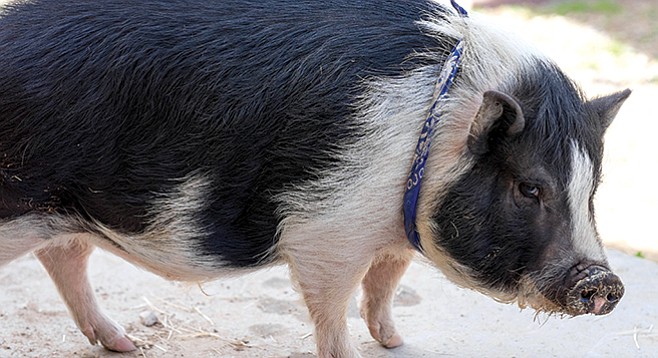
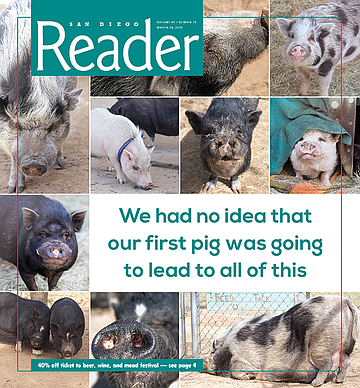
If you make a right onto Dye Road off SR-67 north, past a sign advertising midget wrestling, tucked amidst dusty chaparral and dirt roads, you’ll find Grazin’ Pig Acres. A kitschy “Pig Lover” sign announces the entrance to the sanctuary that is home to 95 abandoned pigs.
What appears to be a pack of curious dogs stand guard. A bramble of patchy grass and a modest ranch home lay in the background. Upon closer inspection, only two of the animals are canines, the others are swine. They snort inquisitively as I enter, wagging their curly tails. They waddle behind me like puppy dogs with paunchy bellies.
Noting my hesitation, a young worker with deep-set dimples and vivid aquamarine dreadlocks pulled back into a sloppy bun, assures me, “It’s okay! None of these guys bite.”
She shakes my hand and introduces herself as Michelle Pannell. Pannell is Grazin’ Pig Acres’ only paid employee and a recent hire. She responded to the rescue’s Craigslist ad seeking part-time help. Prior to Pannell’s employment, proprietors Nancy and Marty Koontz ran the farm on their own with help from two volunteers — one that helps out every Friday and the other who regularly purchases and preps food for the animals. Now in their late 50s, the Koontzes found it increasingly difficult to manage the daily challenges of running the operation on their own. Pannell assists in feeding, cleaning out pens, trimming hooves and tusks, and administering medicine, among other tasks. Pannell, a 20-something vegan, has been working with animals for years.
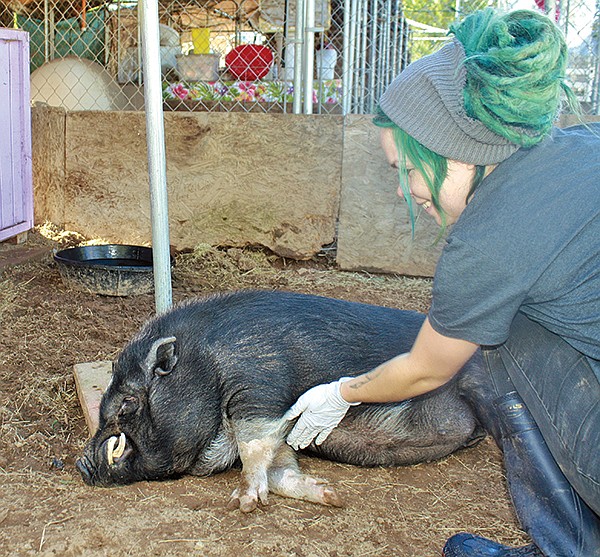
“In San Diego there aren’t many jobs working with animals...well, at least not the kind of animals I want to work with. I definitely wanted to work with commodified animals, the kind of animals people wouldn’t necessarily think need saving. I like to work with and see the value in those animals,” Pannell explains.
Prior to moving to San Diego, Pannell volunteered and interned for rescues in Upstate New York, Utah, and Ironwood Pig Rescue near Tucson, Arizona — home to more than 600 swine.
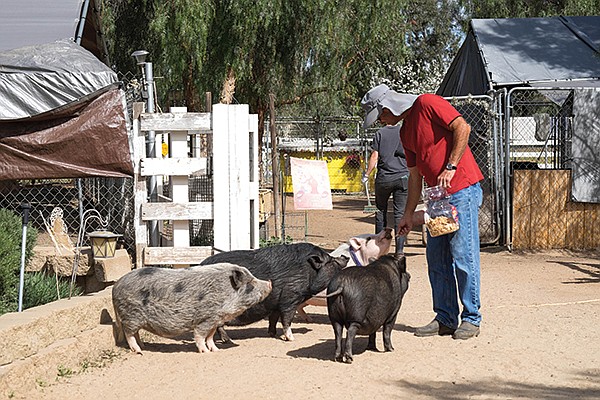
A small group of them trail behind her as she leads me around. Pannell grabs a handful of animal crackers and bribes an oversized, wiry, black-haired pig named Zooey to perform tricks in exchange. Zooey spins around in circles several times before gently taking crackers from Pannell’s open palm. She then strokes the animal lovingly.
Pannell leads me around the side of the property, past a cluster of pig pens, to Nancy Koontz, a tall brunette wearing worn-in jeans, a long-sleeved shirt, and a sun hat. Around her neck hangs a delicate chain with a silver pig charm.
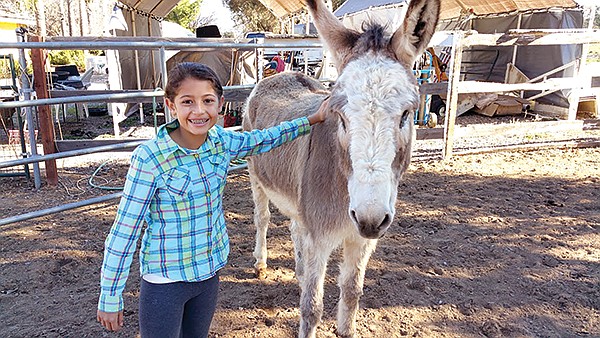
Nancy and her husband Marty own and operate the sanctuary that, along with the pigs, includes a few goats, horses, rabbits, a donkey, and a lamb.
Koontz balances a big jug of animal crackers in one hand while cooing at a chubby pig. “Good Boy, Ziggy! Good Boy!” she praises the pig before introducing him. “This is Ziggy, Ziggy Marley.”
After administering arthritis medication to a nearby pig named Tubby, Koontz leads me around back, away from the snorts and smells. We stand near the back door of the Koontzes’ home, chatting while a couple of dogs and a handful of pigs vie for our attention. Nearby, a tall brown horse, a giveaway from a neighbor who could no longer care for him, stands stoically in its pen.
Nancy explains that she and her husband had no intention of housing an army of swine when they bought their first pot-bellied pig, Bailey.
“This is a 100 percent my husband’s fault!” she says, shaking her head with a laugh. “We lived in Buena Park in 1997 in a tract home. One day Marty came home and said, ‘I want a pig.’ I was, like, ‘What are you talking about? We live in a tract home! We don’t know anything about pigs!’”
Before Nancy can elaborate, Marty Koontz, a slender, stubbly-faced man wearing a ball cap, T-shirt, and jeans approaches. He has just arrived home from his morning shift as a bus driver for the Poway School District. He offers me a hand-shake.
“I was telling her about our first pig,” Nancy explains to her husband with a sly smile. The couple exchange nostalgic smiles.
Marty adds, “I got a hair up my butt about getting a pot-bellied pig. I read about them and I thought, Man, I think having a pig would be cool! We got our first pig from a breeder in Northern California. If I knew then what I knew now, I would’ve never gotten a pig from a breeder! If you look on Craigslist, people are practically giving them away! I think I paid $300 for this pig. He was less than three months old. We fell in love with him.”
Neither Koontz has a farm background. Both grew up in Orange County suburbia.
The couple moved to Ramona with Bailey the pig and two house cats in 1998 after Nancy was offered a nursing position at Kaiser. They bought their current home, a four-and-a-half-acre property in the heart of Ramona. After Bailey died, they purchased two more pot-bellies from a woman who could no longer care for the huge animals. Their names are Scooter and Lulu. The elderly pair still call the sanctuary home.
Before long, word got out that the Koontzes had pot-bellies. “As soon as people found out, they would say, ‘You know, my friend is moving and they have a pig. They can’t take him. Can you take him?’ Or, ‘My friend is in the military, going through a divorce,’ or, you know, whatever other reason. We started taking in a pig here and a pig there. Our family thought we were nuts. I mean, they thought that after we had just the one pig — now we have 95! To say that this happened on accident sounds strange, but it’s true,” Marty says, looking out over the 29 pig pens that lay just yards from his home.
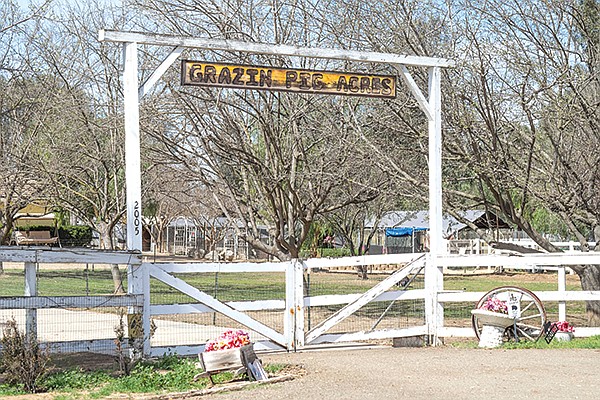
Slowly, the population of Grazin’ Pig Acres grew. In 2002, they had about 26 pigs. When the Cedar and Witch Creek wildfires hit, their population exploded because many people in rural sections of San Diego lost their homes and could no longer care for their animals.
“Most of our animals came from those two big wildfires. One of our biggest rescues ever was in Dulzura. A horse rescue took in 13 pigs. They contacted me to take the pigs. My wife and I went down there to look at these pigs. They had no shelter, they were standing in deep mud with poop and pee; I guess these people were doing the best they could but the pigs were very low priority for them. Anyway, they didn’t separate the males from the females. Three of the pigs were already pregnant. We took in 13 adult pigs and within in two months we had 19 newborns. That is 32 new pigs.”
With the boom in animals, at the end of 2007, Grazin’ Pig Acres became a nonprofit. Friends and family make donations, but the bulk of running and maintaining the sanctuary falls on the Koontzes’ shoulders. From time to time they receive donations of blankets, small monetary donations, and food for the pigs.
The Koontzes spay and neuter all their pigs. They do not sell them and rarely, if ever, give pigs away.
“The pigs live their lives out with us. I get calls from people who want babies; everyone wants a pig under six months old. There are people out there that do want older pigs but it’s really rare. Plus, once they are here for any length of time, we fall in love with them and I can’t get rid of ’em,” says Marty.
The couple gets calls all the time to take in new pigs. Last week they received three calls from people wanting to unload their pigs at Grazin’ Pig Acres.
“I have to say no. We are at a point now where our days are so long. We have 15-hour days. It has become difficult. My wife and I both work. The pigs free-range every day. If they don’t get their free-range time in, my wife and I feel very guilty. We try to accommodate them to give these guys the best life they can have.”
Marty points out that most of the pigs at Grazin’ Pig Acres started out as pets.
“People get them as babies. There is really no demand for adult pigs. Everyone wants a baby. Breeders tell people that their potbellies are only going to weigh 40 pounds full-grown and to only feed them a half a cup of food a day to keep them small.” Marty grimaces at the thought, shaking his head in disgust. “That’s horrible advice. Sometimes I get [pigs] and their ribs are showing, or they have lice and various other skin issues. They get to be a year old and they start to grow. Owners don’t want them anymore. They root in the yards; they are really hard on landscaping. Did you see my lawn? I used to have a beautiful green front lawn and I took a lot of pride in it. That was about 60 pigs ago. I gave up on it. Now the pigs are the priority.”
The pigs at Grazin’ Pig Acres are let out of their cages to eat and free-range in shifts every hour during the day. Three of the pigs — Hamilton, Zooey, and Charlotte — are kept out all day long.
“We call Charlotte and Zooey our divas. They sleep in the garage. One of them even has her own mattress, heated blanket, and body pillow. They are mellow enough to be out all day. They don’t start fights with the other pigs,” Nancy explains.
Says Marty, “I could leave the gate open and they would stay in the yard.”
With a grim look, Marty points out into the distance past the gate. “If you look over there, across the street from us, there is a research building. They have pigs whose feet never touch the ground. They are on raised beds in a totally clean environment. They are raised for medical research. We caught wind of it just before they moved in. We went around and got signatures and let people know what was going on, but you know it was too late; we were just peeing in the wind. They have been there for a few years.”
Marty stopped eating pork and most other meat products nearly 20 years ago, after taking in his first pig. Nancy is a vegetarian.
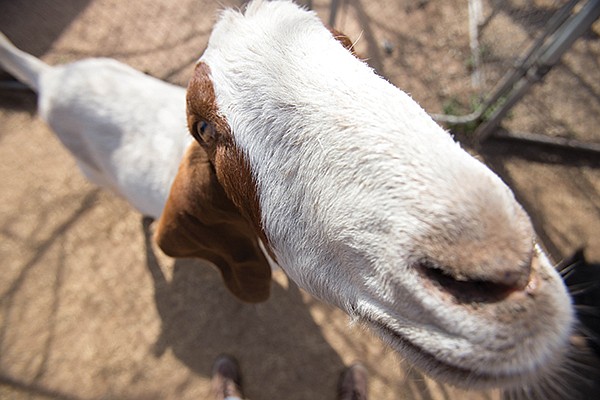
Beckoned by the hungry snorts of the pot-bellies, Nancy sets off to feed the pigs, leaving Marty to act as my tour guide. He leads me through a maze of pig pens. They are surprisingly clean and the odor is tolerable.
The pigs are placed together based on their temperaments. Marty ushers me into the first pen, home to five pigs, a lamb named Lamb Chop, and a pygmy goat named Brigit. A barrel-sized pig named Pumbaa greets us. He lounges lazily near the door. He is pink with black spots. Pumbaa sniffs my feet while Marty rubs his belly.
“You can pet him; he is a lover — a big sweetheart. If you can see, most of his ears are gone. The previous owner had dogs that chewed them off. He got mauled multiple times. He’s our biggest pig. He probably weighs 350 to 400 pounds. Pot-bellies don’t get this big. We think he was bred with a farm pig.”
Marty bends down to rub Pumbaa’s belly. He greets each of the other pigs by name in a sing-songy voice and recalls the details of their rescues.
“This is Mickey,” says Marty, motioning to a smaller black pig. “He was running around the streets of Point Loma when we rescued him.”
A couple of the other pigs in the pen have what Marty refers to as a sad story.
“They came from Wildomar. A guy had an acre of land with over 250 pigs. He was an older gentleman with no way to care for them. I think he was an alcoholic. The pigs were starving. He didn’t separate the males from the females. He started out with 6 pigs; over the years they grew to over 250. The county got involved. Their solution was to shoot the pigs. Another nonprofit caught wind of this and took over rehoming the animals. We took in 13 of them.”
The older pens, toward the east end of the property, are decorated to resemble an old-fashioned Wild West village: hand-painted signs and structures resembling schoolhouses, a saloon with a sign reading “loose women,” and a barber shop with a working barber’s pole decorate the pens. Marty and his dad built the pig village back when their population of pigs was under 25 and the Koontzes had more time to spare.
“It was our intention to make the pens look like an old western city but with 95 pigs we don’t have the time to do all of them that way.” Marty tells me.
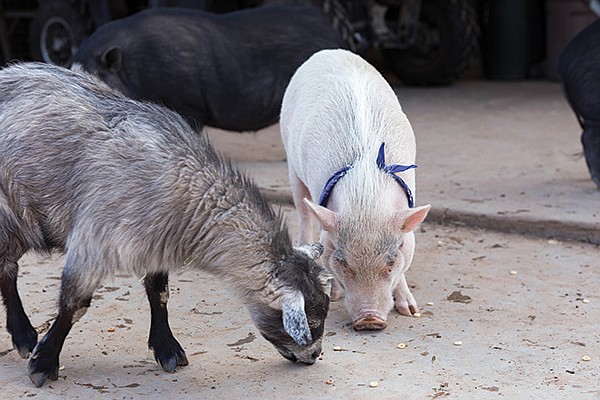
Apart from expenditure of time, there is a heavy price tag on caring for the pigs. With the influx of pigs, the Koontzes began building their pens out of six-by-six-foot aluminum fencing panels from Home Depot. Each panel set them back $75. They need at least eight panels, usually more, to build one pen. Nowadays they find used panels on Craigslist to bring the cost down. The pigs go through roughly 50 pounds of carrots and 50 pounds of feed a day. They also blaze through gallons of animal crackers. Over the years the Koontzes have learned to trim tusks and hooves themselves. A vet charges over $200 to trim the hoofs of just one pig, even more for tusks.
“We spend about $3000–$3500 a month to maintain what we have. Nancy and I both work. We are very fortunate to be able to do this. Instead of driving a Mercedes Benz or having a million-dollar home we have a nice house, decent cars, and 95 pigs.”
Many of their pigs are on medication.
“We have a great vet who tries to give us a good deal but we still pay through the nose on vet bills. Through the years we’ve had a couple of pigs go through surgeries. One had bladder stones, another we opened up to do an exploratory surgery and found out he had cancer. We put him down right there. Vet bills vary year to year. These surgeries I am telling you about were about five grand a piece. It’s a different story when you are spending $3500 a month to maintain what you have to have to spend an additional $5000 on top of that. That’s rough!”
Nancy butts in —“We took out a loan to pay for one of our pig’s surgeries and [Marty] almost divorced me!”
Marty continues, unfazed, ”We get really close to these guys, so when they do fall ill, we want to do what we can to help them. We have some older ones that will probably need to be put down within a year or so. It’s hard. I’ve cried over every one. We know all 95 of their names.”
Adds Nancy, “They are all my favorites. Some of them I like for different reasons, but I try to love them all equally.”
One of the pigs that Nancy named Ham Bone nearly took off one of her fingers after he got spooked during a feeding. She also has a large gash on her arm from a different pot-belly. She doesn’t hold a grudge.
“When the doctor told me he wasn’t sure if he could save my finger, I thought, Well, now I can go by Nine-Finger Nancy and that is a pretty cool nickname.”
The Koontzes do not have children. In a way, they view their pigs as their kids. “It’s kind of like taking care of a bunch of toddlers that never grow up. This is what we do. This is all we do. We have no social life. We come home and do this. It’s very busy. Some days I get wound up because I am so overwhelmed but that just goes with the territory. We don’t regret doing this at all; we just had no idea that our first pig was going to lead to all of this.”



If you make a right onto Dye Road off SR-67 north, past a sign advertising midget wrestling, tucked amidst dusty chaparral and dirt roads, you’ll find Grazin’ Pig Acres. A kitschy “Pig Lover” sign announces the entrance to the sanctuary that is home to 95 abandoned pigs.
What appears to be a pack of curious dogs stand guard. A bramble of patchy grass and a modest ranch home lay in the background. Upon closer inspection, only two of the animals are canines, the others are swine. They snort inquisitively as I enter, wagging their curly tails. They waddle behind me like puppy dogs with paunchy bellies.
Noting my hesitation, a young worker with deep-set dimples and vivid aquamarine dreadlocks pulled back into a sloppy bun, assures me, “It’s okay! None of these guys bite.”
She shakes my hand and introduces herself as Michelle Pannell. Pannell is Grazin’ Pig Acres’ only paid employee and a recent hire. She responded to the rescue’s Craigslist ad seeking part-time help. Prior to Pannell’s employment, proprietors Nancy and Marty Koontz ran the farm on their own with help from two volunteers — one that helps out every Friday and the other who regularly purchases and preps food for the animals. Now in their late 50s, the Koontzes found it increasingly difficult to manage the daily challenges of running the operation on their own. Pannell assists in feeding, cleaning out pens, trimming hooves and tusks, and administering medicine, among other tasks. Pannell, a 20-something vegan, has been working with animals for years.

“In San Diego there aren’t many jobs working with animals...well, at least not the kind of animals I want to work with. I definitely wanted to work with commodified animals, the kind of animals people wouldn’t necessarily think need saving. I like to work with and see the value in those animals,” Pannell explains.
Prior to moving to San Diego, Pannell volunteered and interned for rescues in Upstate New York, Utah, and Ironwood Pig Rescue near Tucson, Arizona — home to more than 600 swine.

A small group of them trail behind her as she leads me around. Pannell grabs a handful of animal crackers and bribes an oversized, wiry, black-haired pig named Zooey to perform tricks in exchange. Zooey spins around in circles several times before gently taking crackers from Pannell’s open palm. She then strokes the animal lovingly.
Pannell leads me around the side of the property, past a cluster of pig pens, to Nancy Koontz, a tall brunette wearing worn-in jeans, a long-sleeved shirt, and a sun hat. Around her neck hangs a delicate chain with a silver pig charm.

Nancy and her husband Marty own and operate the sanctuary that, along with the pigs, includes a few goats, horses, rabbits, a donkey, and a lamb.
Koontz balances a big jug of animal crackers in one hand while cooing at a chubby pig. “Good Boy, Ziggy! Good Boy!” she praises the pig before introducing him. “This is Ziggy, Ziggy Marley.”
After administering arthritis medication to a nearby pig named Tubby, Koontz leads me around back, away from the snorts and smells. We stand near the back door of the Koontzes’ home, chatting while a couple of dogs and a handful of pigs vie for our attention. Nearby, a tall brown horse, a giveaway from a neighbor who could no longer care for him, stands stoically in its pen.
Nancy explains that she and her husband had no intention of housing an army of swine when they bought their first pot-bellied pig, Bailey.
“This is a 100 percent my husband’s fault!” she says, shaking her head with a laugh. “We lived in Buena Park in 1997 in a tract home. One day Marty came home and said, ‘I want a pig.’ I was, like, ‘What are you talking about? We live in a tract home! We don’t know anything about pigs!’”
Before Nancy can elaborate, Marty Koontz, a slender, stubbly-faced man wearing a ball cap, T-shirt, and jeans approaches. He has just arrived home from his morning shift as a bus driver for the Poway School District. He offers me a hand-shake.
“I was telling her about our first pig,” Nancy explains to her husband with a sly smile. The couple exchange nostalgic smiles.
Marty adds, “I got a hair up my butt about getting a pot-bellied pig. I read about them and I thought, Man, I think having a pig would be cool! We got our first pig from a breeder in Northern California. If I knew then what I knew now, I would’ve never gotten a pig from a breeder! If you look on Craigslist, people are practically giving them away! I think I paid $300 for this pig. He was less than three months old. We fell in love with him.”
Neither Koontz has a farm background. Both grew up in Orange County suburbia.
The couple moved to Ramona with Bailey the pig and two house cats in 1998 after Nancy was offered a nursing position at Kaiser. They bought their current home, a four-and-a-half-acre property in the heart of Ramona. After Bailey died, they purchased two more pot-bellies from a woman who could no longer care for the huge animals. Their names are Scooter and Lulu. The elderly pair still call the sanctuary home.
Before long, word got out that the Koontzes had pot-bellies. “As soon as people found out, they would say, ‘You know, my friend is moving and they have a pig. They can’t take him. Can you take him?’ Or, ‘My friend is in the military, going through a divorce,’ or, you know, whatever other reason. We started taking in a pig here and a pig there. Our family thought we were nuts. I mean, they thought that after we had just the one pig — now we have 95! To say that this happened on accident sounds strange, but it’s true,” Marty says, looking out over the 29 pig pens that lay just yards from his home.

Slowly, the population of Grazin’ Pig Acres grew. In 2002, they had about 26 pigs. When the Cedar and Witch Creek wildfires hit, their population exploded because many people in rural sections of San Diego lost their homes and could no longer care for their animals.
“Most of our animals came from those two big wildfires. One of our biggest rescues ever was in Dulzura. A horse rescue took in 13 pigs. They contacted me to take the pigs. My wife and I went down there to look at these pigs. They had no shelter, they were standing in deep mud with poop and pee; I guess these people were doing the best they could but the pigs were very low priority for them. Anyway, they didn’t separate the males from the females. Three of the pigs were already pregnant. We took in 13 adult pigs and within in two months we had 19 newborns. That is 32 new pigs.”
With the boom in animals, at the end of 2007, Grazin’ Pig Acres became a nonprofit. Friends and family make donations, but the bulk of running and maintaining the sanctuary falls on the Koontzes’ shoulders. From time to time they receive donations of blankets, small monetary donations, and food for the pigs.
The Koontzes spay and neuter all their pigs. They do not sell them and rarely, if ever, give pigs away.
“The pigs live their lives out with us. I get calls from people who want babies; everyone wants a pig under six months old. There are people out there that do want older pigs but it’s really rare. Plus, once they are here for any length of time, we fall in love with them and I can’t get rid of ’em,” says Marty.
The couple gets calls all the time to take in new pigs. Last week they received three calls from people wanting to unload their pigs at Grazin’ Pig Acres.
“I have to say no. We are at a point now where our days are so long. We have 15-hour days. It has become difficult. My wife and I both work. The pigs free-range every day. If they don’t get their free-range time in, my wife and I feel very guilty. We try to accommodate them to give these guys the best life they can have.”
Marty points out that most of the pigs at Grazin’ Pig Acres started out as pets.
“People get them as babies. There is really no demand for adult pigs. Everyone wants a baby. Breeders tell people that their potbellies are only going to weigh 40 pounds full-grown and to only feed them a half a cup of food a day to keep them small.” Marty grimaces at the thought, shaking his head in disgust. “That’s horrible advice. Sometimes I get [pigs] and their ribs are showing, or they have lice and various other skin issues. They get to be a year old and they start to grow. Owners don’t want them anymore. They root in the yards; they are really hard on landscaping. Did you see my lawn? I used to have a beautiful green front lawn and I took a lot of pride in it. That was about 60 pigs ago. I gave up on it. Now the pigs are the priority.”
The pigs at Grazin’ Pig Acres are let out of their cages to eat and free-range in shifts every hour during the day. Three of the pigs — Hamilton, Zooey, and Charlotte — are kept out all day long.
“We call Charlotte and Zooey our divas. They sleep in the garage. One of them even has her own mattress, heated blanket, and body pillow. They are mellow enough to be out all day. They don’t start fights with the other pigs,” Nancy explains.
Says Marty, “I could leave the gate open and they would stay in the yard.”
With a grim look, Marty points out into the distance past the gate. “If you look over there, across the street from us, there is a research building. They have pigs whose feet never touch the ground. They are on raised beds in a totally clean environment. They are raised for medical research. We caught wind of it just before they moved in. We went around and got signatures and let people know what was going on, but you know it was too late; we were just peeing in the wind. They have been there for a few years.”
Marty stopped eating pork and most other meat products nearly 20 years ago, after taking in his first pig. Nancy is a vegetarian.

Beckoned by the hungry snorts of the pot-bellies, Nancy sets off to feed the pigs, leaving Marty to act as my tour guide. He leads me through a maze of pig pens. They are surprisingly clean and the odor is tolerable.
The pigs are placed together based on their temperaments. Marty ushers me into the first pen, home to five pigs, a lamb named Lamb Chop, and a pygmy goat named Brigit. A barrel-sized pig named Pumbaa greets us. He lounges lazily near the door. He is pink with black spots. Pumbaa sniffs my feet while Marty rubs his belly.
“You can pet him; he is a lover — a big sweetheart. If you can see, most of his ears are gone. The previous owner had dogs that chewed them off. He got mauled multiple times. He’s our biggest pig. He probably weighs 350 to 400 pounds. Pot-bellies don’t get this big. We think he was bred with a farm pig.”
Marty bends down to rub Pumbaa’s belly. He greets each of the other pigs by name in a sing-songy voice and recalls the details of their rescues.
“This is Mickey,” says Marty, motioning to a smaller black pig. “He was running around the streets of Point Loma when we rescued him.”
A couple of the other pigs in the pen have what Marty refers to as a sad story.
“They came from Wildomar. A guy had an acre of land with over 250 pigs. He was an older gentleman with no way to care for them. I think he was an alcoholic. The pigs were starving. He didn’t separate the males from the females. He started out with 6 pigs; over the years they grew to over 250. The county got involved. Their solution was to shoot the pigs. Another nonprofit caught wind of this and took over rehoming the animals. We took in 13 of them.”
The older pens, toward the east end of the property, are decorated to resemble an old-fashioned Wild West village: hand-painted signs and structures resembling schoolhouses, a saloon with a sign reading “loose women,” and a barber shop with a working barber’s pole decorate the pens. Marty and his dad built the pig village back when their population of pigs was under 25 and the Koontzes had more time to spare.
“It was our intention to make the pens look like an old western city but with 95 pigs we don’t have the time to do all of them that way.” Marty tells me.

Apart from expenditure of time, there is a heavy price tag on caring for the pigs. With the influx of pigs, the Koontzes began building their pens out of six-by-six-foot aluminum fencing panels from Home Depot. Each panel set them back $75. They need at least eight panels, usually more, to build one pen. Nowadays they find used panels on Craigslist to bring the cost down. The pigs go through roughly 50 pounds of carrots and 50 pounds of feed a day. They also blaze through gallons of animal crackers. Over the years the Koontzes have learned to trim tusks and hooves themselves. A vet charges over $200 to trim the hoofs of just one pig, even more for tusks.
“We spend about $3000–$3500 a month to maintain what we have. Nancy and I both work. We are very fortunate to be able to do this. Instead of driving a Mercedes Benz or having a million-dollar home we have a nice house, decent cars, and 95 pigs.”
Many of their pigs are on medication.
“We have a great vet who tries to give us a good deal but we still pay through the nose on vet bills. Through the years we’ve had a couple of pigs go through surgeries. One had bladder stones, another we opened up to do an exploratory surgery and found out he had cancer. We put him down right there. Vet bills vary year to year. These surgeries I am telling you about were about five grand a piece. It’s a different story when you are spending $3500 a month to maintain what you have to have to spend an additional $5000 on top of that. That’s rough!”
Nancy butts in —“We took out a loan to pay for one of our pig’s surgeries and [Marty] almost divorced me!”
Marty continues, unfazed, ”We get really close to these guys, so when they do fall ill, we want to do what we can to help them. We have some older ones that will probably need to be put down within a year or so. It’s hard. I’ve cried over every one. We know all 95 of their names.”
Adds Nancy, “They are all my favorites. Some of them I like for different reasons, but I try to love them all equally.”
One of the pigs that Nancy named Ham Bone nearly took off one of her fingers after he got spooked during a feeding. She also has a large gash on her arm from a different pot-belly. She doesn’t hold a grudge.
“When the doctor told me he wasn’t sure if he could save my finger, I thought, Well, now I can go by Nine-Finger Nancy and that is a pretty cool nickname.”
The Koontzes do not have children. In a way, they view their pigs as their kids. “It’s kind of like taking care of a bunch of toddlers that never grow up. This is what we do. This is all we do. We have no social life. We come home and do this. It’s very busy. Some days I get wound up because I am so overwhelmed but that just goes with the territory. We don’t regret doing this at all; we just had no idea that our first pig was going to lead to all of this.”
Comments